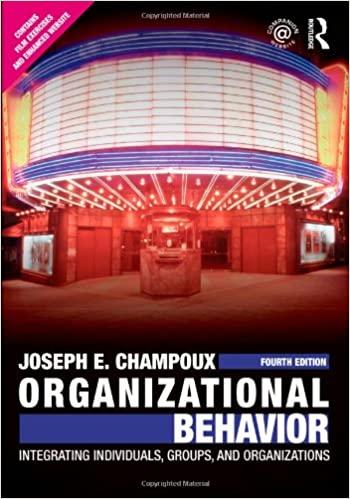Discuss the different methods of improving decision making in organizations. Which of these methods do you expect
Question:
Discuss the different methods of improving decision making in organizations. Which of these methods do you expect to find widely used in organizations? Discuss differences in how easy each it is to use method of improvement.
IMPROVING DECISION MAKING IN ORGANIZATIONS
Many methods exist to improve decision making in organizations. Some are human-based methods; others use computers and related technologies.
Human-Based Methods
The human-based methods for improving decision making are designed to generate more decision alternatives or to increase the criticism of the alternatives. Some methods also increase conflict in a decision-making group to offset the liabilities of such groups.
Brainstorming is a method of improving decision making that involves spontaneously generating ideas while deferring critical evaluation of those ideas. Its role in the decision process is to create a set of decision alternatives, not to pick the final alternative.
Four rules guide brainstorming. First, group members generate ideas in a freewheeling fashion. Wacky ideas are welcome. Second, at this stage there is no criticism of any idea, no matter how bizarre or bland. Third, many ideas are desired. The assumption is that, if people suggest many ideas, some will be good ones. Fourth, after ideas are presented, group members suggest ways to combine or improve them. At the end of a brainstorming session, decision makers should have many alternative solutions to a problem or issue.
A new approach to brainstorming uses computer technology to improve the results of the process. Some research has shown that face-to-face brainstorming does not always yield as many good alternatives as people working alone. The lack of anonymity in a face-to-face group inhibits some people from offering their ideas. Electronic brainstorming links people by computers so they do not interact directly. Participants behave anonymously in the process, letting them offer ideas without fear of social pressure from a dominant person. Electronic groups, described in detail in Chapter 10, “Groups and Intergroup Processes,” are the broader example of using technology in decision-making groups.
The nominal group technique (NGT) is a procedure for generating large amounts of information about a decision problem. The NGT uses a structured approach to decision making that is useful for generating, evaluating, and choosing alternative courses of action. It is a special case of brainstorming that does not include direct interaction. Research evidence shows NGT as outperforming the interactive brainstorming just described. NGT usually creates more ideas of at least equal quality.
During the early stages of the NGT, members of the decision-making group do not interact or talk with each other. Instead, they write their ideas about the decision problem on paper. After about 20 minutes, each person reads one idea from her list. Another person records each idea on a flip-chart in full view of all members of the group. The reading and recording continue with each member presenting one idea at a time, until all ideas are recorded.
During the reading and recording phase, no discussion takes place. By the end of this phase, the group has generated its set of ideas for the decision problem. The group then discusses the ideas on the flip-chart. After the discussion, each group member votes privately on the ideas. Finally, the individual votes are pooled to arrive at a decision about the problem.
The Delphi method is a structured technique for making decisions that are surrounded by uncertainty or that are conflicting values laden. This method also is used when group members are geographically scattered. Forecasting future events and determining public policy are examples of the types of decisions that can use the Delphi method.
Computer-Based Methods
Computer-based methods of improving decisions in organizations include management information systems, decision support systems, and expert systems. The rapid spread of computer-based methods means you will likely encounter some of these systems in your work career.
Management information systems are information processing systems used by organizations to support their daily operating activities and decision-making functions. The systems can be manual, but are most powerful when they are computer based. Management information systems integrate different subsystems according to a general information management plan. Data within the subsystems conform to the specifications of the integrated system, allowing easy sharing throughout the system. Multiple users reach the management information system with terminals or personal computers (PCs). Users get a wide range of data, decision models, and database querying methods. Management information systems strongly support the analytical, strategic planning, and decision activities of an organization.
Step by Step Answer:

Organizational Behavior Integrating Individuals Groups And Organizations
ISBN: 9780415804646
4th Edition
Authors: Joseph E. Champoux





